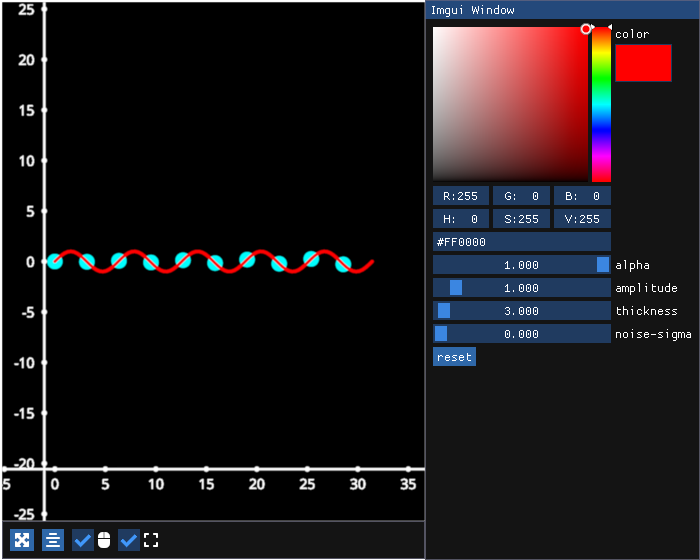Note
Go to the end to download the full example code.
ImGUI Basics#
Basic examples demonstrating how to use imgui in fastplotlib.
See the imgui docs for extensive examples on how to create all UI elements: https://pyimgui.readthedocs.io/en/latest/reference/imgui.core.html#imgui.core.begin_combo

/home/runner/work/fastplotlib/fastplotlib/fastplotlib/graphics/features/_base.py:18: UserWarning: casting float64 array to float32
warn(f"casting {array.dtype} array to float32")
# test_example = true
import numpy as np
import fastplotlib as fpl
# subclass from EdgeWindow to make a custom ImGUI Window to place inside the figure!
from fastplotlib.ui import EdgeWindow
from imgui_bundle import imgui
# make some initial data
np.random.seed(0)
xs = np.linspace(0, np.pi * 10, 100)
ys = np.sin(xs) + np.random.normal(scale=0.0, size=100)
data = np.column_stack([xs, ys])
# make a figure
figure = fpl.Figure(size=(700, 560))
# make some scatter points at every 10th point
figure[0, 0].add_scatter(data[::10], colors="cyan", sizes=15, name="sine-scatter", uniform_color=True)
# place a line above the scatter
figure[0, 0].add_line(data, thickness=3, colors="r", name="sine-wave", uniform_color=True)
class ImguiExample(EdgeWindow):
def __init__(self, figure, size, location, title):
super().__init__(figure=figure, size=size, location=location, title=title)
# this UI will modify the line
self._line = self._figure[0, 0]["sine-wave"]
# set the default values
# wave amplitude
self._amplitude = 1
# sigma for gaussian noise
self._sigma = 0.0
def update(self):
# the UI will be used to modify the line
self._line = figure[0, 0]["sine-wave"]
# get the current line RGB values
rgb_color = self._line.colors[:-1]
# make color picker
changed_color, rgb = imgui.color_picker3("color", col=rgb_color)
# get current line color alpha value
alpha = self._line.colors[-1]
# make float slider
changed_alpha, new_alpha = imgui.slider_float("alpha", v=alpha, v_min=0.0, v_max=1.0)
# if RGB or alpha changed
if changed_color | changed_alpha:
# set new color along with alpha
self._line.colors = [*rgb, new_alpha]
# example of a slider, you can also use input_float
changed, amplitude = imgui.slider_float("amplitude", v=self._amplitude, v_max=10, v_min=0.1)
if changed:
# set y values
self._amplitude = amplitude
self._set_data()
# slider for thickness
changed, thickness = imgui.slider_float("thickness", v=self._line.thickness, v_max=50.0, v_min=2.0)
if changed:
self._line.thickness = thickness
# slider for gaussian noise
changed, sigma = imgui.slider_float("noise-sigma", v=self._sigma, v_max=1.0, v_min=0.0)
if changed:
self._sigma = sigma
self._set_data()
# reset button
if imgui.button("reset"):
# reset line properties
self._line.colors = (1, 0, 0, 1)
self._line.thickness = 3
# reset the data params
self._amplitude = 1.0
self._sigma = 0.0
# reset the data values for the line
self._set_data()
def _set_data(self):
self._line.data[:, 1] = (np.sin(xs) * self._amplitude) + np.random.normal(scale=self._sigma, size=100)
# make GUI instance
gui = ImguiExample(
figure, # the figure this GUI instance should live inside
size=275, # width or height of the GUI window within the figure
location="right", # the edge to place this window at
title="Imgui Window", # window title
)
# add it to the figure
figure.add_gui(gui)
figure.show()
# NOTE: fpl.loop.run() should not be used for interactive sessions
# See the "JupyterLab and IPython" section in the user guide
if __name__ == "__main__":
print(__doc__)
fpl.loop.run()
Total running time of the script: (0 minutes 0.790 seconds)
